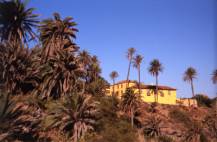
Was is it?
Rambla de Castro Protected Landscape consists of a series of sea cliffs, sheer-sided along some stretches, flanked to the west by a section of flat land where the Godínez (La Calera) ravine meets the sea and to the east by Los Roques beach. The western side of the area is home to one of the finest palm groves on the island, along with spurge and a number of halophilous (salt-loving) plant species that have taken root in an area of abandoned crop terraces. However, these plants are only a remnant of the abundant community that once populated this site and whose beauty and scientific value attracted a multitude of naturalists over the course of many years.
The area also features a mansion surrounded by palm trees, once owned by the distinguished Canary Islands family of Castro, and the ruins of the old San Fernando fort, which was built in the early 19th century and still has the original cannon used to defend this stretch of the coast. It is also home to the Gordejuela pumping station, which housed the island's first steam engine.
Getting there
Rambla de Castro Protected Landscape can be accessed from the TF-5 at kilometre 41+200, via the exit for the Mirador de San Pedro in Los Realejos. You can park your vehicle at the Mirador and continue on to the protected area on foot via the path leading down from the Mirador.
Total area
45.9 ha.
Municipality
Los Realejos
Governing legislation
Rambla de Castro was declared a Protected Landscape by Autonomous Region Act 12/94, which was later integrated into the Organisation of the Canary Islands Territory Act via Legislative Decree 1/2000. To better control the activities that could impact upon it, a later addition to Act 12/94 extended the status of area of environmental sensitivity to all the terrain included within the Protected Landscape and beyond it into the areas that border it to the south.

 Print
Print